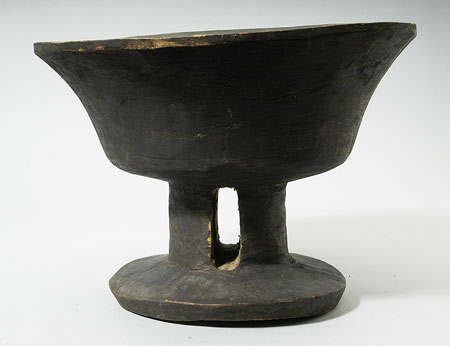Accession Number:
1948.2.135
Country:
Sudan
Region:
[Southern Sudan]
Cultural Group:
Zande
Date Made:
By 1930
Materials:
Wood Plant , Pigment
Process:
Carved , Stained
Dimensions:
Ht = 254, rim diam ext. = 347 x 343, mouth diam = 290, pedestal W = 107, th = 105.6, window W = 27, base L = 210, W = 196, th = 23.5 mm [RTS 13/4/2005].
Weight:
>1000g
Other Owners:
Probably collected by Evans-Pritchard himself during his fieldwork amongst the Zande, which took place during 1927, part of 1928 and 1929 and for several months during 1930 [CM; RTS 6/7/2004].
Field Collector:
Edward Evan Evans-Pritchard
PRM Source:
Edward Evan Evans-Pritchard
Acquired:
Found unentered February 1948
Collected Date:
1927 - 1930
Description:
Oval bowl carved from a single block of wood and consisting of an everted flat-topped rim with narrow edge, on a deep body with concave sides that flare down to a low carination, then convexly in to the bowl underside.
This has been set on top of a short cylindrical pedestal foot that flares out to a broad disc base with thick bevelled edge sloping in to a flat base.
2 oval windows have been cut into opposite sides of the pedestal, connecting at its centre; these have 2 concave scallops cut along the base.
The bowl interior has sides that slope down and in to a flat base.
The execution is somewhat irregular, and one side of the bowl sits higher than the other.
The bowl interior, base underside and fenestrations have all been left the natural yellow colour of the wood (Pantone 7508C), while the top of the rim and exterior surfaces have been stained a dark brownish black (Pantone black 7C).
The wood itself is soft and lightweight.
The bowl is complete and intact, but has some kind of crack or flaw running around the base interior.
There is some wear around the rim edges, and some of the stain colour has marked the foot underside, while vertical dribbles of stain are visible around the outer walls.
It has a height of 254 mm, with an external rim diameter of 347 by 343 mm and mouth diameter of 290 mm; the pedestal is 107 mm wide and 105.6 mm thick, with a window cut through it 27 mm wide; the base of the foot measures 210 by 196 mm and is 23.5 mm thick.
Collected by Edward Evan Evans-Pritchard during his fieldwork amongst the Zande, which took place during 1927, part of 1928 and 1929 and for several months during 1930.
Wooden bowls and stools were carved by specialist craftsmen from several species of green timber, probably during the dry season, and were used by the people form whom they were acquired. The black staining and polishing was done by the owners themselves.
This may be the type of bowl that Larken describes as follows: ".. more elaborate, and therefore, in less general use, is a dish with a deep circular bowl, attractively curved, on a massive carved and sometimes pierced stem and a round base, in form resembling a goblet or fruit-stand, cut out of solid wood, about eighteen inches high and half as wide" (P.M. Larken, 1927, "Impressions of the Azande", Sudan Notes and Records X, p. 132).
For similar Zande bowls, but with pyramidal rather than cylindrical feet, see 1948.2.132 (with a solid foot), 1948.2.130 and 1948.2.135 (both with fenestrated feet).
Rachael Sparks 18/9/2005.
Collected by Edward Evan Evans-Pritchard during his fieldwork amongst the Zande, which took place during 1927, part of 1928 and 1929 and for several months during 1930.
Wooden bowls and stools were carved by specialist craftsmen from several species of green timber, probably during the dry season, and were used by the people form whom they were acquired. The black staining and polishing was done by the owners themselves.
This may be the type of bowl that Larken describes as follows: ".. more elaborate, and therefore, in less general use, is a dish with a deep circular bowl, attractively curved, on a massive carved and sometimes pierced stem and a round base, in form resembling a goblet or fruit-stand, cut out of solid wood, about eighteen inches high and half as wide" (P.M. Larken, 1927, "Impressions of the Azande", Sudan Notes and Records X, p. 132).
For similar Zande bowls, but with pyramidal rather than cylindrical feet, see 1948.2.132 (with a solid foot), 1948.2.130 and 1948.2.135 (both with fenestrated feet).
Rachael Sparks 18/9/2005.
Primary Documentation:
Accession Book Entry
[p.
264] - E.
E.
EVANS-PRITCHARD, INSTITUTE OF SOCIAL ANTHROPOLOGY, OXFORD.
Found unentered; collected by donor.
[p, 265] 1948.2.135 - ZANDE.
Wooden bowl; [insert] standing on [end insert] short vertical stem and circular flat base.
Painted black outside, Plain.
13" across top, 9" high.
Card Catalogue Entry - There is no further information on the catalogue card [RTS 2/2/2004].
Pitt Rivers Museum label - AFRICA, Sudan. ZANDE. Wooden bowl with fenestrated pedestal foot. Coll. E.E. Evans-Pritchard. Found unentered Feb. 1948.1948.2.135 [plastic coated label, tied to object; RTS 9/4/2005].
Written on object - ZANDE [pencil]; ZANDE. 1948.2.135. d.d. EVANS-PRITCHARD [ink, RTS 9/4/2005].
Card Catalogue Entry - There is no further information on the catalogue card [RTS 2/2/2004].
Pitt Rivers Museum label - AFRICA, Sudan. ZANDE. Wooden bowl with fenestrated pedestal foot. Coll. E.E. Evans-Pritchard. Found unentered Feb. 1948.1948.2.135 [plastic coated label, tied to object; RTS 9/4/2005].
Written on object - ZANDE [pencil]; ZANDE. 1948.2.135. d.d. EVANS-PRITCHARD [ink, RTS 9/4/2005].




